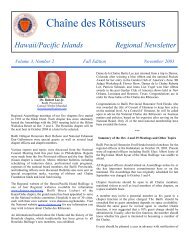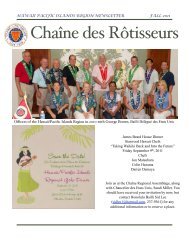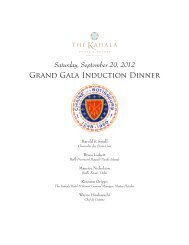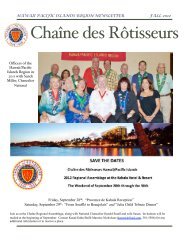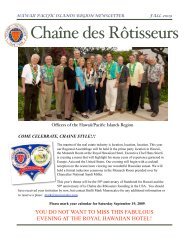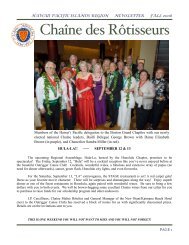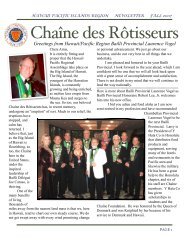Judith Kellogg: The Medieval Aristocratic Table - Chaine des ...
Judith Kellogg: The Medieval Aristocratic Table - Chaine des ...
Judith Kellogg: The Medieval Aristocratic Table - Chaine des ...
You also want an ePaper? Increase the reach of your titles
YUMPU automatically turns print PDFs into web optimized ePapers that Google loves.
FINE DINING THROUGH THE AGESFine dining has always beenthe hallmark of the Chaîne <strong>des</strong>Rôtisseurs, from the early artisanswho prepared roasted meats for theirliege lords to today’s black-tie events.However, what constitutes finedining has been very different fromone era to the next. In this issue,Gastronome begins a four-part seriesthat will explore fine dining throughthe ages. With this installment, wetransport you back in time to a royalbanquet where our ancestor, thegoose roaster, is hard at work.Part 1: <strong>The</strong> <strong>Medieval</strong> <strong>Aristocratic</strong> <strong>Table</strong>By <strong>Judith</strong> <strong>Kellogg</strong>, Hawaii/Pacific Islands Chargée de Presse ProvincialeImagine a banquet setting where attendeesare dressed up in their finest silk, furs, and jewels.<strong>The</strong> venue is palatial, the walls hung with elaboratetapestries. Flames crackle in the massive fireplace.While serenading musicians mingle with the nobleretinue, dogs hover expectantly. Diners will remain for manyhours, perhaps even for several days, to savor a feast so lavishin scale that even the most extravagant Chaîne dinners of todaywould pale in comparison.Such banquets were the sociopolitical centerpieces of aristocraticlife in the Middle Ages, and our Chaîne ancestors—the royalgoose roasters—would have contributed to them extensively.During the Middle Ages, food embodied political clout amongthe wealthy. As culinary historian Bridget Henisch noted, “In thecut-throat realities of everyday life, to nourish was not so muchan act of love as a demonstration of power.… Lavish generositywas the hallmark of the important man” (Henisch, 10-11). Nobles,including kings, were sometimes bankrupted by extravagancebecause evidence of frugality could be met with contempt. HenryIII’s motto was, “He who does not give what he has, does notreceive what he wants.” Ironically, he also exemplified a powerfulman falling from grace. When reckless spending caused himto simplify his hosting, he was lambasted in a 1250 chronicle:“<strong>The</strong> lord king, shamelessly departing from his father’s footsteps,ordered the expenses of his court and the customary pleasures ofhospitality to be cut back, even so as to incur the reproach of inexcusableavarice” (Paris, 141).Given this highly charged cultural dynamic around food, thenoble medieval meal was an elaborate performance, orchestratedto appeal to all of the senses. Quantities were immense. Since thewealthy could afford spices unavailable to most, rich sauces wereexpected. <strong>The</strong>n, as now, French wines held a privileged place atthe table. Serving vessels were of gold, silver, or refined earthenware,the most coveted pottery made in Spain.Lavish dishes were presented in succession, and each wasappreciated in its own right without regard for the menu’s balance,as in a modern Chaîne dinner. One record enumerates twenty-sixcourses for one meal. Another document from circa 1400 lists theprojected supplies for a two-day meal for five hundred guests asfollows: domestic meats, game meats, fish in remarkable quantitiesand varieties, eggs (12,000), spices (the essentials being ginger,20 GASTRONOME VOLUME 1 2011
cinnamon, cloves, grains of paradise, longpepper, spikenard, black and white pepper,mace, saffron, galingale, and nutmeg),nuts, fruits, cheeses, flour (3,600 lbs.),colorants (including eighteen lbs. of goldleaf), spiced candies, vinegar (832 gallons),verjuice (1,040 gallons), oil, andwines for cooking (Scully, 41-42).Food also became art. It was oftenpainted or sculpted; sometimes it wasembellished with gold, enamel, jewels,and ivory. Dishes were fashionedto resemble battlements and towers.Sometimes, fare portrayed imaginedbeasts. For instance, spiced pork bellymight be shaped like a hedgehog, withfried almonds representing the bristles.Occasionally, food conveyed a message. Atthe coronation feast for Henry V in 1413,six roast cygnets were arranged around aroast swan to suggest the homage of thegreat barons to the newly crowned king.Spectacle was paramount andextended beyond food presentation, withentertainment punctuating the myriadcourses. Musicians, acrobats, animaltrainers, magicians, comedians, singers,storytellers, and mimes performedat medieval feasts. Sometimes intricate“interlu<strong>des</strong>,” or short plays, were presented.In contrast was the simplicity ofthe table, where bread, a cup, a knife,and one’s fingers were the essentials.Fine white linen was required. One wasexpected to bring one’s own knife, thehandle as fancy as one could afford. Goodwhite bread served as spoon, plate, andtowel. Diners ate with their fingers fromcommon platters and pots, dipping breadinto the sauces. One generally shareda cup, so etiquette required that one’smouth be cleaned of grease or food beforedrinking. <strong>The</strong> well bred were taught towipe their hands and knives on table-(Above) <strong>The</strong> medieval banquet.(Left) Illustrated manuscript showing amedieval meal being cooked and served.(Right)Banquet hall.(Below)Sampling newwine.(Opposite)<strong>Aristocratic</strong>hunting meal.cloths only after cleaning them first withbread. Shared washbowls, infused withsage, rosemary, chamomile, or rose petals,were available before and after meals.Bones and other refuse were droppedon the floor, where the canine palaceresidents served as enthusiastic clean-upcrews.Formal manners were strictlyprescribed and studied. Powerfularistocrats established reputations forgenerous hospitality at banquets, whileguests demonstrated their nobilitythrough refined manners. In the earlyMiddle Ages, military prowess determinedVOLUME 1 2011 GASTRONOME 21
Grape harvest.Milking sheep.(Left) Stewing lamb.one’s social rank. As the centuries progressed, traditionalchivalric knights became obsolete in practice and ladiestook on more prominent social roles. “Courtesy”—theart of proper public “court” behavior—distinguished theelite.It took countless people and a vast castle infrastructureto prepare a medieval banquet. Although lowin social standing, a skillful cook who could coordinatemeals was highly valued. Nobles wanted a cook whoresembled “a wizard, ready to work his magic on a handfulof ingredients and transform them into a dish fit for aking. Any cook who could do this named his own price,rested on his ladle, and waited to be wooed” (Henisch,71). Although lowly kitchen boys did the actual turning,the “art” included managing the fire, placing the spit,preparing sauces, and overseeing the decoration.But what of the poor goose, who made notable,albeit less enthusiastic, contributions to the medievaltable? <strong>The</strong> sentiments of his cousin, the swan, no doubtecho his own. An anonymous thirteenth-century poetrecords the swan’s lament, which is best known for itsinclusion in Carl Orff’s Carmina Burana (based on themedieval poetry collection of that name).Aforetime, by the waters wan,This lovely body I put on:In life I was a stately swan.Ah me! Ah me!Now browned and basted thoroughly.(Left) An herb garden.<strong>The</strong> cook now turns me round and turns me.<strong>The</strong> hurrying waiter next concerns me,But oh, this fire, how fierce it burns me!(Below) Bridal banquet.Ah me! Ah me!(Whicher, 251)UWorks CitedHenisch, Bridget, Fast and Feast: Food in <strong>Medieval</strong> Society. UniversityPark: University of Pennsylvania Press, 1997.Paris, Matthew, <strong>The</strong> Illustrated Chronicles of Matthew Paris:Observations of Thirteenth Century Life, trans. Richard Vaughan.Cambridge, UK: Alan Sutton, 1993.Scully, D. Eleanor and Terence, Early French Cookery: Sources,History, Original Recipes and Modern Adaptations. Ann Arbor:University of Michigan Press, 1995.Whicher, George, editor and translator, <strong>The</strong> Goliard Poets: <strong>Medieval</strong>Latin Songs and Satires. New York: New Directions, 1965.22 GASTRONOME VOLUME 1 2011



